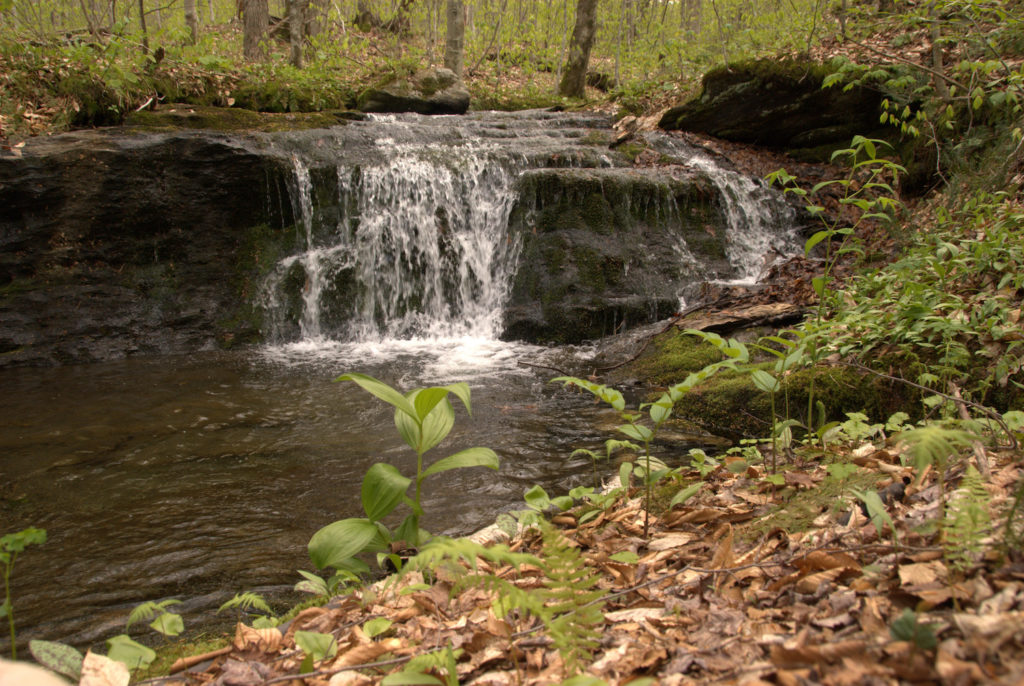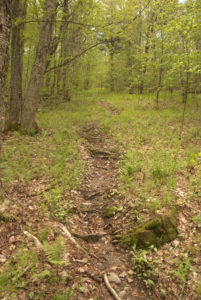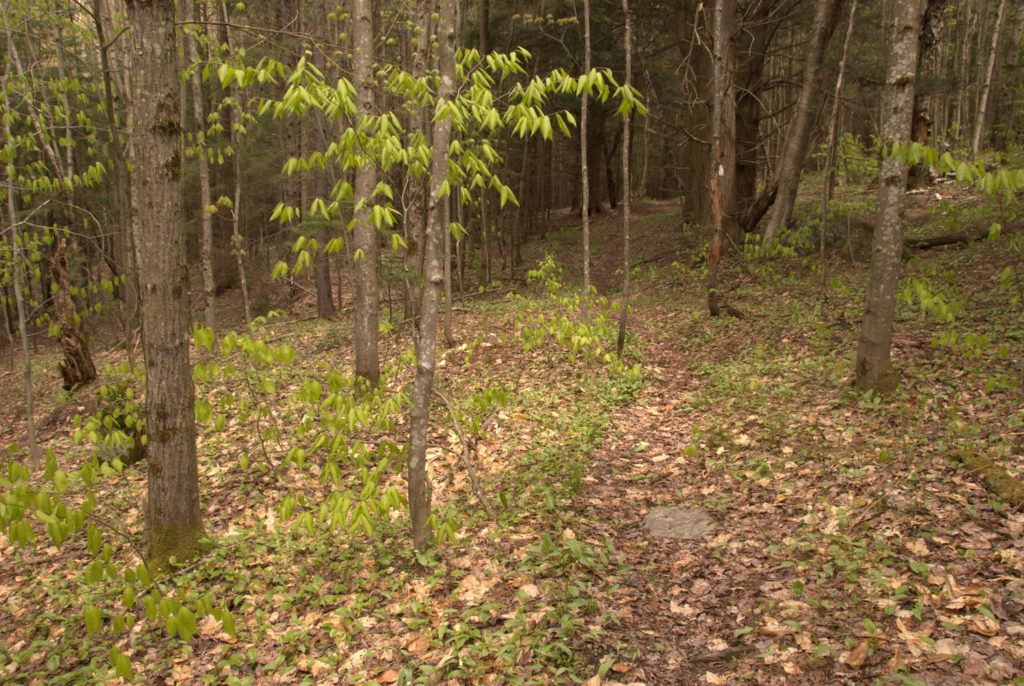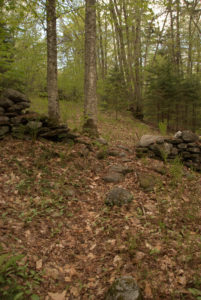The Fall 2020 Codding Hollow property conservation agreement protects one-third of a mile of Long Trail in Johnson and Waterville. You can read more about the protection in this press release.
This article was written by GMC Conservation Manager Mollie Flanigan and appears in the Winter 2020 Long Trail News.

In September the Green Mountain Club (GMC) joined its partners, The Trust for Public Land and the Vermont Department of Forests, Parks and Recreation, in celebrating the conservation of the Codding Hollow property in Waterville and Johnson. The acquisition protects 160.7 acres of forested landscape and one-third of a mile of the Long Trail, a critical stretch for the long-distance hiking trail where any gap could sever its continuity.
Thirty-four years in the making, the accomplishment depended on the efforts of countless individuals and organizations who maintained relationships with the landowners, brainstormed creative trail protection scenarios, raised funds to support three decades of GMC’s land protection program, and finally signed the deeds.
Why did it take so long to protect this modest but crucial parcel in northern Vermont? GMC’s three-inch thick land protection file for the property tells the complex story of Vermont land use philosophies, trail management priorities, public relations, tax law, and real estate deals that made Codding Hollow a thirty-four-year project.
The Path to Conservation for the Codding Hollow Property
1986 – GMC launches the Long Trail Protection Campaign. GMC has never mounted a capital campaign before. More than 60 miles of Long Trail in northern Vermont are located on private properties, protected only by the generosity of landowners and handshake agreements. Large tracts of timberland in northern Vermont are on the market, and GMC estimates that more than 30 miles of trail could be affected by their sale.
1990 – GMC establishes a relationship with the Codding Hollow property owner, a Vermont-based timber company with multiple landholdings. The landowner is willing to discuss options for permanently protecting the Long Trail route but is not interested in anything that would prohibit timber harvesting along the trail or restrict sale of the land later. GMC and the landowner consider a possible land sale or donation, conservation easement, or trail right-of-way.
1991 – GMC and the landowner continue to discuss trail protection options and example trail rights-of-way are shared and discussed.
1992– The Green Mountain Club Board considers National Scenic Trail (NST) designation for the Long Trail, primarily motivated by the time and money it could take for the GMC to protect the Long Trail without federal support. (GMC had considered NST designation in 1975, 1986, and 1990, but had rejected the idea for fear that national designation would increase use of the already stressed trail system. GMC hoped that its land protection effort could succeed without federal involvement.) GMC’s Land Protection Committee estimates that under the current protection program, it would take more than $5 million and at least eight more years to protect the entire Long Trail.

The Codding Hollow landowner lets GMC know that he’s “very gun-shy of having to deal with the federal government.” He is interested in working with GMC on an easement under development but fears the federal government would disregard the terms of an easement and restrict his property rights if the trail received NST designation.
1993 – Governor Howard Dean asks GMC to pursue National Scenic Trail (NST) designation. A motion passes at GMC’s Annual Meeting “that in cooperation with appropriate interested parties, the GMC proceed to draft federal legislation for federal protection for the Long Trail subject to later Board approval of wording before introduction in Congress.”
The Codding Hollow landowner learns of the vote, again expresses his concerns with federal involvement, and says that if GMC proceeds with legislation, he would want the trail routed away from his property. GMC tries to reassure him that if NST designation were granted, an easement would be grandfathered and recognized as trail protection, and the property would not be subject to eminent domain. The landowner’s concerns are not assuaged, and he expresses concerns about pursuing an easement with GMC.
1994 – GMC’s Land Protection Committee has been working since the summer of 1993 to draft NST legislation. Public meetings held around the state gather opinion from the public, GMC members and landowners in an attempt to build support for the controversial designation. The primary question is how eminent domain authority would be handled by the legislation and how that could affect landowners along the Long Trail.
In September GMC’s board votes by a large majority to seek legislation to add the Long Trail System to the National Scenic Trail System. Proposed legislation stipulates that “eminent domain authority will be limited to the main route of the Long Trail and will not apply to side trails. Landowners who have agreed to protect the Trail corridor, both prior to and following the passage of legislation, will not be subject to eminent domain. Eminent domain can be used only as a last resort when no other means will protect the Trail and is limited to a maximum corridor of 1000 feet.” – GMC Long Trail News, Winter 1994
In November the owner of the Codding Hollow property writes GMC a strongly worded letter stating that NST designation is “incompatible with the goals” of the timber company and that “it is particularly disturbing to us that our fifty years of good-will and volunteer trail protection will now be ‘rewarded’ with a taking.” The letter demands that “upon receipt of this letter you should actively proceed with relocating the trail off of the property.”
GMC responds, asking the landowner to reconsider the relocation demand until they have reviewed the legislation wording, and the landowner agrees to suspend the relocation demand.
1995 – Conversations with the landowner continue, discussing purchasing all or part of the property. The landowner is inclined to wait to see how GMC moves forward with NST designation before committing to any action. The Nature Conservancy discusses possibly helping to facilitate a land swap to conserve the Codding Hollow property with some recently donated land to the Conservancy. As a result of the 1994 mid-term election and continued public feedback, GMC decides to not pursue legislation designating the Long Trail as a National Scenic Trail.
1996 – The land swap with The Nature Conservancy doesn’t work out, but GMC offers to look for land to exchange for the Codding Hollow property. The landowner is open to the offer.
1997 – A land exchange is still being discussed, but a suitable property has not been identified.
A neighboring property is opened for logging, and the Codding Hollow landowner is interested in conducting the harvest. Access to the neighboring land is through a GMC conservation easement. GMC tries to leverage the required permission to get protection for the trail on the Codding Hollow property, but the landowner is not interested.
1998 – GMC purchases a neighboring property and offers to allow the Codding Hollow landowner to harvest the timber in exchange for Long Trail protection. The two parties discuss a long-term management agreement in exchange for a 25-acre protection zone for the Long Trail on the Codding Hollow property, but problems with the terms of the agreement emerge.
2002 – GMC learns that the landowner is interested in selling their timber lands in Vermont, including the Codding Hollow property. GMC asks to buy the property or secure a trail right-of-way before the sale. An appraisal is conducted but the landowner asks for a purchase price that is deemed “outrageous” by GMC and GMC decides a purchase isn’t worth pursuing with the current owners.
The landowner works with LandVest, a New England timberland management and real estate firm, to bundle their Vermont holdings—a total of 7,000 acres in 15 parcels—and offer them for sale for $6.5 million.
GMC talks with The Nature Conservancy and the Vermont Land Trust to see if a collaboration to purchase the bundle is possible.

2003 – The 7,000 acres are sold to an investment firm, and LandVest continues to manage the properties. GMC establishes a relationship with the new landowner.
2004 – GMC discusses its interest in the Codding Hollow property with the new landowner, and the owner expresses a willingness to do a land exchange, proposing a 3:1 acreage ratio because they want to increase their holdings. Both parties look into potential properties for a land exchange.
2007 – The landowner tells GMC they are interested in selling a bundle of their Vermont holdings called the Green Mountain Portfolio. GMC makes an offer to buy just the Codding Hollow property. The landowner considers the offer, but decides to sell the bundle of properties together instead.
2008 – The Green Mountain Portfolio is on the market. GMC continues to express an interest in purchasing the Codding Hollow property. GMC discusses the Green Mountain Portfolio with The Trust for Public Land to see whether the bundle could be purchased and protected as a larger conservation project.
2009 – A timber harvest is conducted on the Codding Hollow property. The forester gives GMC reassurance of a light-cut buffer along the Long Trail and promises to “make an effort to keep skid trail crossings to a minimum, ideally just one crossing, and will post signs on the trail warning of logging activity.”
2011 – The timber harvest on the Codding Hollow property wraps up. GMC gets the property appraised and makes an offer to the landowner, but the offer is rejected as too low. The landowner moves forward with selling the Green Mountain Portfolio.
2013 – The Green Mountain Portfolio properties are purchased by a privately held limited liability corporation. LandVest continues to manage the Codding Hollow property.
GMC and The Trust for Public Land launch the Partnership for the Green Mountains, a collaboration to strategically conserve priority lands surrounding the Long Trail.
2015 – LandVest lets GMC know that the landowner understands GMC’s interest in the Codding Hollow property and is willing to sell GMC the tract. The sale can happen once the landowner finds a comparable property to buy so as to not decrease the acreage of his holdings. GMC works with The Trust for Public Land to monitor the land deal, since GMC’s internal land protection capacity has decreased in recent years.
2019 – LandVest tells The Trust for Public Land that the landowner has found a comparable property and is ready to sell the Codding Hollow tract. The Trust for Public Land gets the property under contract, and the State of Vermont invests $130,000 in the project through a legislative appropriation so the land can become part of the Long Trail State Forest. The towns of Johnson and Waterville support adding the land to the state forest system. The Trust for Public Land, GMC, and the Vermont Department of Forests, Parks, and Recreation work to conserve the property.
2020 – The Codding Hollow property is purchased by the State of Vermont and incorporated in the Long Trail State Forest. GMC purchases a conservation easement for the Long Trail on the property.

When immersed in the continuing work of managing and stewarding a 110-year old resource like the Long Trail, it is easy to forget the hard work, generous support and bold vision that has gone into making the resource a reality. The conservation of Codding Hollow is a chance to celebrate the vision, vigilance and effort that it takes to steward the Long Trail. Its conservation is a critical addition to the quilt of conserved lands the Long Trail traverses. It fits perfectly into the design composed of more than a hundred other trail protection projects that GMC has worked on, and it joins the countless other conserved lands in Vermont open for public recreation today.
Thank you and congratulations to all the members, donors, supporters, landowners and partners who have brought the Codding Hollow project to fruition! We especially want to thank Bari & Peter Dreissigacker for supporting this project.



















[…] recently, Andy took over monitoring the Codding Hollow parcel, the latest acquisition in GMC’s long-term land protection campaign, and an effort that […]